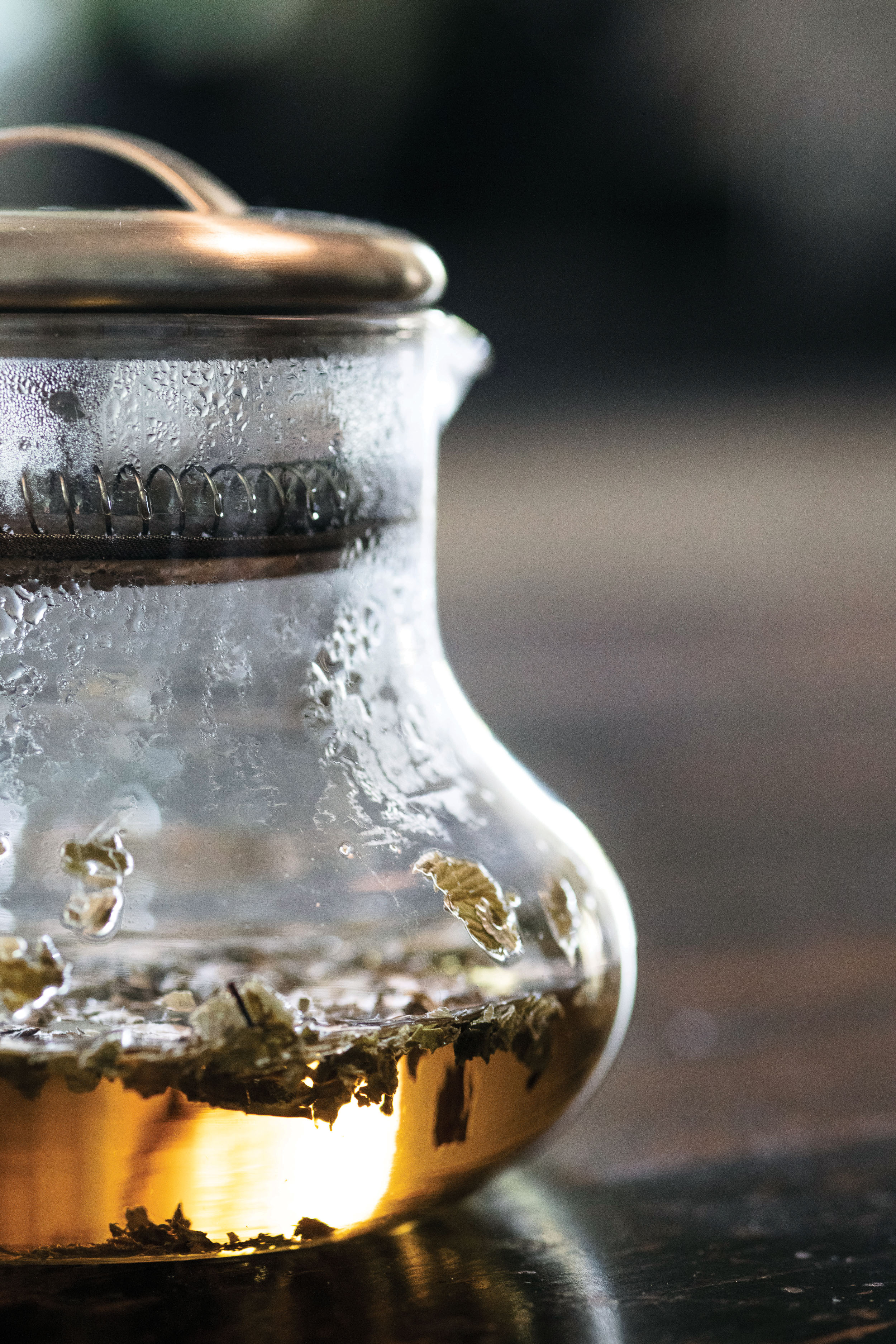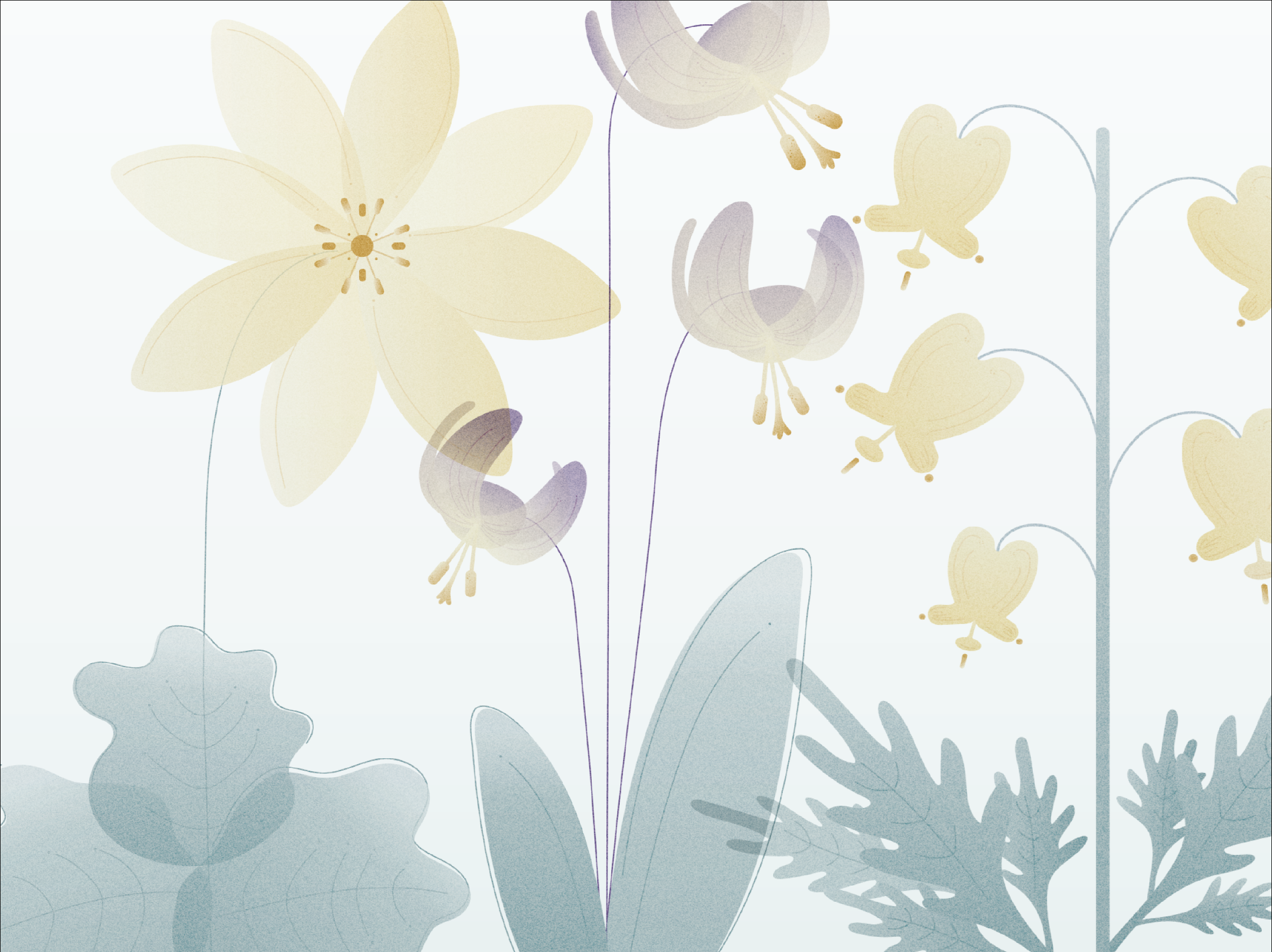Caffeine Buzz

photography by Julie Kramer
From Asia to South America to Cincinnati, an aficionado samples his way through the world of tea.
I can’t tell you exactly when I fell headlong into the rabbit hole that is that most ancient and rewarding of drinks: tea. My dad is English; the love of “a cuppa” runs in my blood. But ours was an instant-coffee household. Later, I spent a decade as a barista, earnestly discussed “mouthfeel” and “flavor profiles” with customers through the latte craze of the late 1990s. Standing at a hissing La Pavoni espresso machine, I was amazed by how caffeine—to us a stimulant but to the plants an insecticide—has made coffee and tea into global commodities.
I’d played around with tea, but it wasn’t until someone gifted me some cakes of fermented, compressed Chinese Pu’er tea that I became a little obsessed.
The leaf of Camellia sinensis yields cups of every flavor and hue. Just as interesting are its chemical complexities: beneficial antioxidants and amino acids including L-theanine, which contours your caffeine absorption, relaxes, and lengthens focus. Goodbye jitters; hello sustained Alpha-wave state. Can overindulgence lead to serious insomnia? You bet. Does “tea drunkenness” exist? I’m here to tell you, friends: It’s real. But consumed with care, excellent tea will take you to a place of sustained concentration and heightened senses.
A Source for Global Tea Lovers
Recently, producers and consumers are turning to tea as a means of healing and an economic boost for indigenous cultures and the ecosystems in which they exist. It’s an interesting twist to a global product that was long based on exploitation. To learn more, I turned to regional tea entrepreneurs and experts, beginning with Katherine Kern of Churchill’s Fine Teas, which offers hundreds of mountain-grown, organic, and organic-compliant teas at their Findlay Market and Rookwood Commons locations.
Kern’s parents, Kathleen and Jerry, started Churchill’s Fine Teas about 10 years ago in part because her mother, who is English, couldn’t get good quality tea like she was used to having at home. The shop had been my go-to for amazing Earl Greys, so it was there that I turned when I became entranced with the properties of Pu’er and green teas. At Churchill’s I bought my first bag of Japanese Gyokuru, or “Jade Dew,” a high-grade green that holds up to multiple infusions that open up one after the other like Russian dolls.
Kern travels extensively and hand-carries teas back to her shop. She says she’s seen an uptick in interest in the health benefits of tea and in ethically sourced teas. Kern told me about a forest-friendly tea from Northern Thailand sourced from a region where wild tea tree leaves have been picked, fermented, and traditionally eaten. As this practice has fallen off with younger generations, the forest where the tea grows has come under threat from economic pressures and deforestation, as farmers looked to other forms of profit from the land. Kern met an ecologically minded importer who was working with producers to convert tea production for the contemporary market and, hopefully, save the forests where the tea is grown. In the process, she came across one of the most unique teas Churchill’s has seen.
But it’s not enough to drink tea and hope that market forces will save a forest and a way of life. “It’s great that [the importer] is working with these farmers, but I also recognize their need to make a certain amount of money,” Kern says. Aficionados should be prepared to pay an appropriate price. “We did a tasting with some of our customers saying, ‘This is going to be a more expensive tea, there’s going to be less supply available.’”
The feedback, she says, was fantastic. She sold out of the tea and a number of customers committed to paying that premium, out of an appreciation for both a fine, unique tea and for what it represents.
Tea is about so much more than consumption and gratification—it’s a relationship that thrives on understanding. That’s why Churchill’s stocks “organic compliant” leaves from smaller growers for whom spending on expensive organic certifications isn’t viable. “They’re still producing great quality teas that would meet [organic] criteria,” Kern says. She personally visits many of the shop’s tea producers. “It just really helps us to ask, ‘Are we thinking about it just from our perspective and our customer’s perspective, or are we thinking about it from the producers’ perspective as well?’ Because they’re the ones who have the traditions. They understand the impact on the soil.”
Teas of North America
I’ve only dipped my toe in the broad, bottomless, and ancient river of Asian teas. But taking the term “tea” loosely, with an interest in both stimulant-induced wakefulness and the environment, led me to infusions grown closer to home.
Yerba Mate, Ilex paraguariensis, is a type of holly that is brewed and sipped prodigiously in South America. And this traditional rainforest crop is being parlayed into economic security for indigenous peoples, which helps protect swaths of threatened rainforest. I picked up a bag sold by Guayaki Sustainable Rainforest Products at my local Kroger. I was pleasantly surprised by how similar it was to Camellia.
Mate is sipped through straws from gourds in Argentina. It has a pleasant smokiness and astringency. Most intriguing, like shade-grown Camellia, it’s rich in antioxidants and includes its own side-car molecule, an alkaloid closely related to caffeine, theobromine, which we know and love best from cacao. Theobromine is both a mild stimulant and psychoactive agent, shown to enhance calmness and cognition.
In Ecuador they steep Guayusa, a holly relative of Mate. It’s less astringent and has a natural grassiness and sweetness. It’s known for sustained stimulation without a crash because, get this, like Camellia, it contains L-theanine.
From these caffeinated hollies, it was a short leap for me to another, one that grows almost in our back yard. Yaupon, the only native North American plant known to contain caffeine, is the leaf with the lowest carbon footprint per cup for the North American sleepyhead.
Indigenous North Americans have shared this dark tea for millennia. Today, this native of the Southeastern coastal U.S. is used as a landscaping plant. During the Civil War, in lieu of coffee or Camellia, blockaded Southerners used it to make “Carolina Tea.” The sustainability of this domestic harvest is undeniable.
I wanted to try it, so I called Chuck Pfahler, founder of the local artisan coffee roaster La Terza. He’ll offer teas and coffee at his latest storefront endeavor, Adesso, which is slated to open soon in Mason.
Pfahler was as keen to taste Yaupon and Guayusa as I was. We staged an impromptu brew-up to which, in addition to his discriminating palate, he brought a cache of dank, pungent herbals he’d collected while traveling through Central America and while foraging here in Cincinnati. He dubbed our tea party “a celebration of American ‘teas.’” We put the kettle on.
Pfahler first steeped a Black Raspberry leaf tea he’d handpicked from Gorman Heritage Farm, then dried and fermented. This free, locally foraged tea had a heady, raspberry nose but resembled an Oolong on the tongue. Also handpicked by Pfahler in Central America: the meaty, purple blossoms of Flor de Jamaica, a type of hibiscus, which infused to a brilliant fuchsia, with a balanced, passion fruit-like sweetness and tanginess.
While visiting the coffee harvest in Honduras, Pfahler had handpicked a couple of tisanes that come from the coffee plant itself: Flor de Cafe, or coffee blossoms, which brew up with surprising hints of jasmine, and Cascara, or coffee cherry tea, which is brewed from the dried husks of the coffee cherry. It’s a traditional infusion made using a part of the coffee harvest that is usually discarded. Pfahler detected notes of baked apple, raisins, and honey.
While Pfahler worked his magic, I steeped some Guayusa and Yaupon. I sourced these online, respectively, from Wild Foods and from Texas-based CatSpring Yaupon and Floridian producers Yaupon Brothers.
The coarse flakes of Guayusa smell like the forest floor, with just a hint of the smoke familiar to drinkers of Yerba Mate. They steeped amber, with a silky sweetness and soft mouthfeel that contrasts with the bite of Mate. I had previously tried a green yaupon from CatSpring that was similar to Mate, but with a very spicy finish. We sampled their dark-roasted Yaupon. Pfahler picked up malt with hints of maple. They made this native North American pick-me-up delicious.
Pfahler embodies the spirit of exploration you can bring to tea. He creates spreadsheets of infusion times and tasting notes. I ask whether it’s important to approach tea scientifically.
“That’s the beauty of tea,” he says. “You don’t have to.
“A lot of teas do get better, especially with second and third steepings,” he says. “Particularly you’ll find that with Oolongs.”
Both Kern and Pfahler regularly visit their coffee and tea producers. When the right relationship flourishes between independent sellers in our community and small growers around the world—well, that’s when the magic happens, bringing to light unique varieties and flavors that would be lost in a larger import-export market.
Best of all, well-traveled entrepreneurs like Kern and Pfahler can relay firsthand the story of where and by whom a tea is grown, how they process the leaves, how it is a way of life.
Regardless of where it’s grown, whether it’s Camellia or one of the Ilexes of the Americas, Kern says, what’s interesting to her is that even though different teas come from different plants, “they’re very similar in that it’s part of a culture. It’s not just about drinking the tea, it’s about that experience you have drinking tea with other people.”
Ever since his grandfather put him to work squashing potato bugs and shoveling compost in a vast organic garden north of Philadelphia, Cedric has loved the outdoors. These days, he squashes bugs for his green-thumbed partner, Jen. His writing has appeared in Saveur, Cincinnati, This Old House, and Belt magazines. He is the Collector at the Mercantile Library Downtown.







